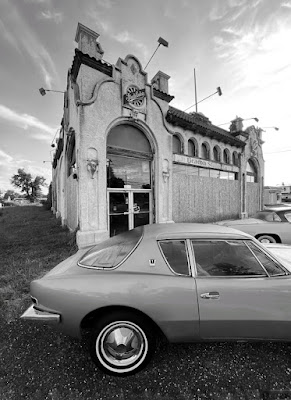Hot on the heels of my interview with Shawn Koenig, hearse collector (last blog I posted on March 15, 2025), I thought I’d be writing about this image. Its a photograph I submitted for consideration in a curated art exhibition. The show is called “Chrome,” and is being held at Box Spring Gallery in Philadelphia.
Box Spring Gallery: “Chrome,” April 2025 Exhibition
The visual elements and design of the automobile as
encountered on the street, in motion, or as imagined.
Here was my artist’s statement about the piece:
The smooth rounded curves of this ghostly antique hearse
contrast with the rigid tombstones in this dream-like scene. The roof's banded
chrome and the vehicle's grill serve to accent its gently arched back. However,
this offers little solace as even at a glance, the viewer knows this 1947
Pontiac Superior hearse gave many their last ride. Since Victorian times,
hearses have been regally designed with only a few chrome flourishes (usually
the decorative "S" shaped landeau bars on their sides). This particular
model is banded with an unusually aggressive chrome strip across its roof,
which seems to symbolically separate the driver from the driven, the living
from the dead.
I shot the image on expired 35mm film with a Nikon F3 camera
– if that means anything to anyone anymore. An expired hearse in an expired
graveyard shot on expired film with an expired camera. The film was Fujicolor,
maybe ten years out of date (hence the reticulation, or severe graininess of the image). Here’s the original image below, which I desaturated
digitally to make the monochrome version. The black and white submission was
turned down.
Maybe there wasn’t enough chrome. Maybe the color version would have appealed more to the jury. Maybe the jury thought the subject matter too morbid. Maybe it did not blend well with all the other chosen entries. These would be all on the wall next to each other. Curators have an amazing ability to create a flow, a collection of work that complements each other. Perhaps the hearse just didn’t add anything to the overall body of work. Were there too many hearse submissions?
Maybe, just maybe, my photograph simply wasn’t good
enough. As an artist, you need to consider such a preposterous idea. The
curator is expecting to sell the artwork on display (and they always get a commission),
so they need to consider the salability of the piece.
My photograph below is what they chose to be in the exhibition, a digital photograph of a non-hearse, for which I am immensely grateful. Public hangings
are an experience unto themselves, especially group shows. You get to see other
artists’ interpretations of the same theme and usually meet them to talk shop
if there is an opening reception. Always inspirational.
I had submitted both photographs, in case the hearse was deemed inappropriate for the exhibition. And so it was. I love all these images, I love the design of both automobiles. So if you want to see my non-hearse
photograph in all it’s 11x14 matted and framed glory, details for Box Spring
Gallery’s opening reception at the Crane Arts Building are shown below. Crane
Arts in Philadelphia’s Fishtown neighborhood is home to several galleries, all of
which host opening receptions for new shows on the same night. So it’s a lot of
fun - wine and cheese, crudité, me, and so on. Sometimes the patrons are as
interesting to view as the art.
The 2nd Thursday Opening Reception is on April 10, 6–9 pm at Box Spring Gallery, 1400 N. American St, #100C, Philadelphia, PA 19122. The exhibition will run from April 10 – May 3, 2025.
A juried prize will be announced. Two participating artists will be selected to show their work in a July 2025 two-person exhibition at Box Spring Gallery.
If I happen to be chosen, I do have a few hearse images I
will try to weasel into the exhibit!
A bit of background on my non-hearse photograph:
Who would not hit the brakes while driving up South Jersey's
Black Horse Pike when presented with this scene of incomparable beauty? In
2023, a vintage 1963 Studebaker Avanti was parked in front of the vintage
(defunct) Studebaker dealership in Pleasantville, New Jersey. I have always
thought the Avante to be one of the most striking automotive designs ever. I'd
love for you to see its subtle chrome accents against the sensual lines of its
gold fiberglass body, but monochrome better expresses its aggressive and sinewy
contours. Juxtaposed against the 1927 Spanish Revival stucco building, the
design of this automobile appears all the more exotic. Only 2500 Avantis were
made between 1962 and 1963.



